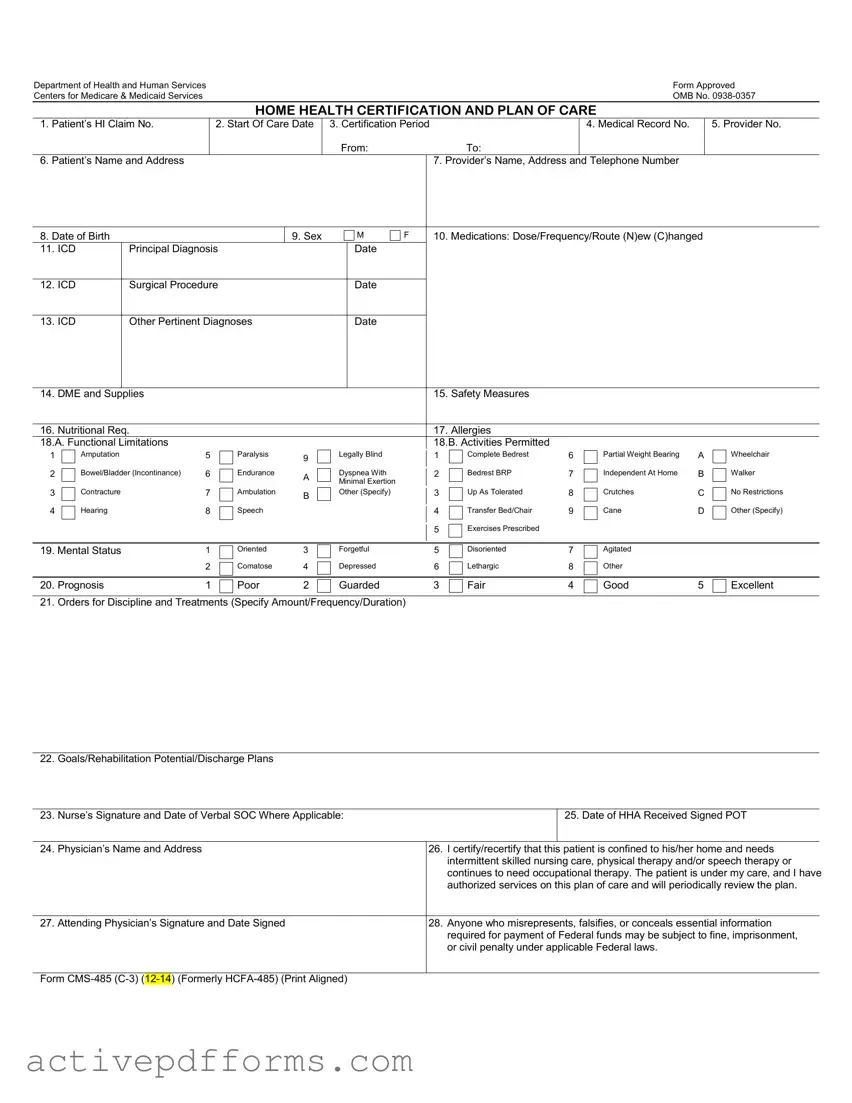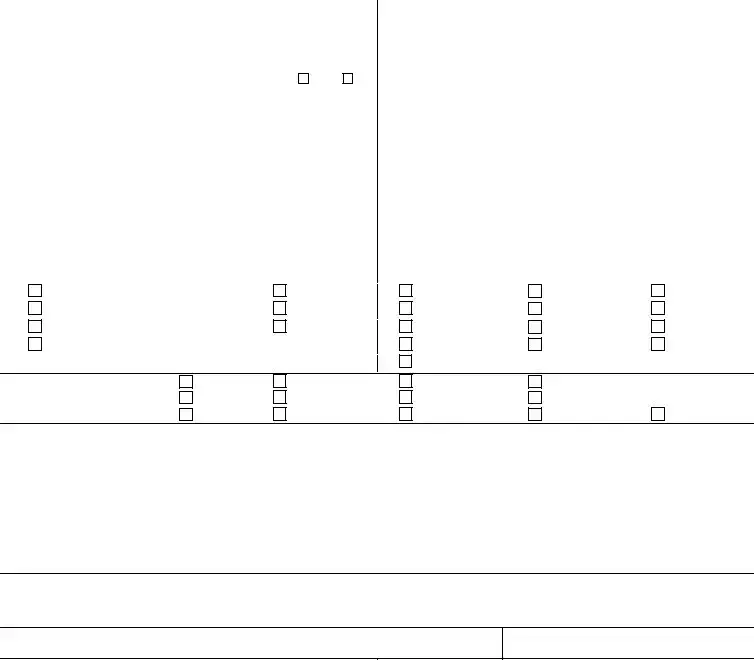Department of Health and Human Services |
Form Approved |
Centers for Medicare & Medicaid Services |
OMB No. 0938-0357 |
HOME HEALTH CERTIFICATION AND PLAN OF CARE
1. |
Patient’s HI Claim No. |
2. Start Of Care Date |
3. Certification Period |
|
4. Medical Record No. |
5. Provider No. |
|
|
|
From: |
To: |
|
|
6. |
Patient’s Name and Address |
|
|
7. Provider’s Name, Address and Telephone Number |
|
8. Date of Birth |
|
9. Sex |
M |
F |
10. Medications: Dose/Frequency/Route (N)ew (C)hanged |
11. ICD |
Principal Diagnosis |
|
Date |
|
|
|
|
|
|
|
|
12. ICD |
Surgical Procedure |
|
Date |
|
|
|
|
|
|
|
|
13. ICD |
Other Pertinent Diagnoses |
|
Date |
|
|
|
|
|
|
|
|
14. |
DME and Supplies |
15. |
Safety Measures |
|
|
|
|
16. |
Nutritional Req. |
17. |
Allergies |
18.A. Functional Limitations |
18.B. Activities Permitted |
Amputation |
5 |
|
Paralysis |
9 |
|
|
|
|
Bowel/Bladder (Incontinance) |
6 |
|
Endurance |
A |
|
|
|
|
|
Contracture |
7 |
|
Ambulation |
B |
|
|
|
|
|
Hearing |
8 |
|
Speech |
|
|
|
|
|
|
|
|
Legally Blind
Dyspnea With
Minimal Exertion
Other (Specify)
Complete Bedrest |
6 |
Bedrest BRP |
7 |
Up As Tolerated |
8 |
Transfer Bed/Chair |
9 |
Exercises Prescribed |
|
Partial Weight Bearing |
A |
Independent At Home |
B |
Crutches |
C |
Cane |
D |
Wheelchair
Walker
No Restrictions
Other (Specify)
19. Mental Status |
1 |
Oriented |
3 |
Forgetful |
5 |
Disoriented |
7 |
Agitated |
|
|
|
2 |
Comatose |
4 |
Depressed |
6 |
Lethargic |
8 |
Other |
|
|
|
|
|
|
|
|
|
|
|
|
|
20. Prognosis |
1 |
Poor |
2 |
Guarded |
3 |
Fair |
4 |
Good |
5 |
Excellent |
21. Orders for Discipline and Treatments (Specify Amount/Frequency/Duration)
22. Goals/Rehabilitation Potential/Discharge Plans
23. Nurse’s Signature and Date of Verbal SOC Where Applicable:
25. Date of HHA Received Signed POT
24. |
Physician’s Name and Address |
26. |
I certify/recertify that this patient is confined to his/her home and needs |
|
|
|
intermittent skilled nursing care, physical therapy and/or speech therapy or |
|
|
|
continues to need occupational therapy. The patient is under my care, and I have |
|
|
|
authorized services on this plan of care and will periodically review the plan. |
|
|
|
|
|
27. |
Attending Physician’s Signature and Date Signed |
28. |
Anyone who misrepresents, falsifies, or conceals essential information |
|
|
|
required for payment of Federal funds may be subject to fine, imprisonment, |
|
|
|
or civil penalty under applicable Federal laws. |
|
|
|
|
|
Form CMS-485 (C-3) (12-14) (Formerly HCFA-485) (Print Aligned)
Privacy Act Statement
Sections 1812, 1814, 1815, 1816, 1861 and 1862 of the Social Security Act authorize collection of this information. The primary use of this information is to process and pay Medicare benefits to or on behalf of eligible individuals. Disclosure of this information may be made to: Peer Review Organizations and Quality Review Organizations in connection with their review of claims, or in connection with studies or other review activities, conducted pursuant to Part B of Title XI of the Social Security Act; State Licensing Boards for review of unethical practices or nonprofessional conduct; A congressional office from the record of an individual in response to an inquiry from the congressional office at the request of that individual.
Where the individual’s identification number is his/her Social Security Number (SSN), collection of this information is authorized by Executive Order 9397. Furnishing the information on this form, including the SSN, is voluntary, but failure to do so may result in disapproval of the request for payment of Medicare benefits.
Paper Work Burden Statement
According to the Paperwork Reduction Act of 1995, no persons are required to respond to a collection of information unless it displays a valid OMB control number. The valid OMB control number for this information collection is 0938-0357. The time required to complete this information collection is estimated to average 15 minutes per response, including the time to review instructions, search existing data resources, gather the data needed, and complete and review the information collection. If you have any comments concerning the accuracy of the time estimate(s) or suggestions for improving this form, please write to: CMS, Mailstop N2-14-26, 7500 Security Boulevard, Baltimore, Maryland 21244-1850.

